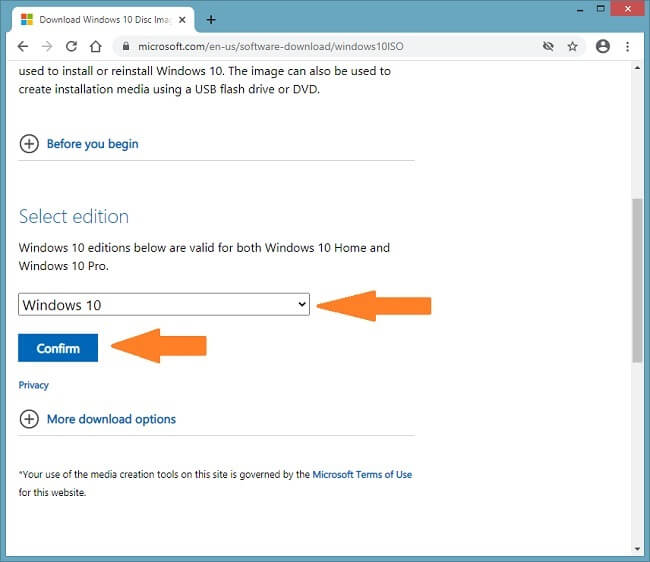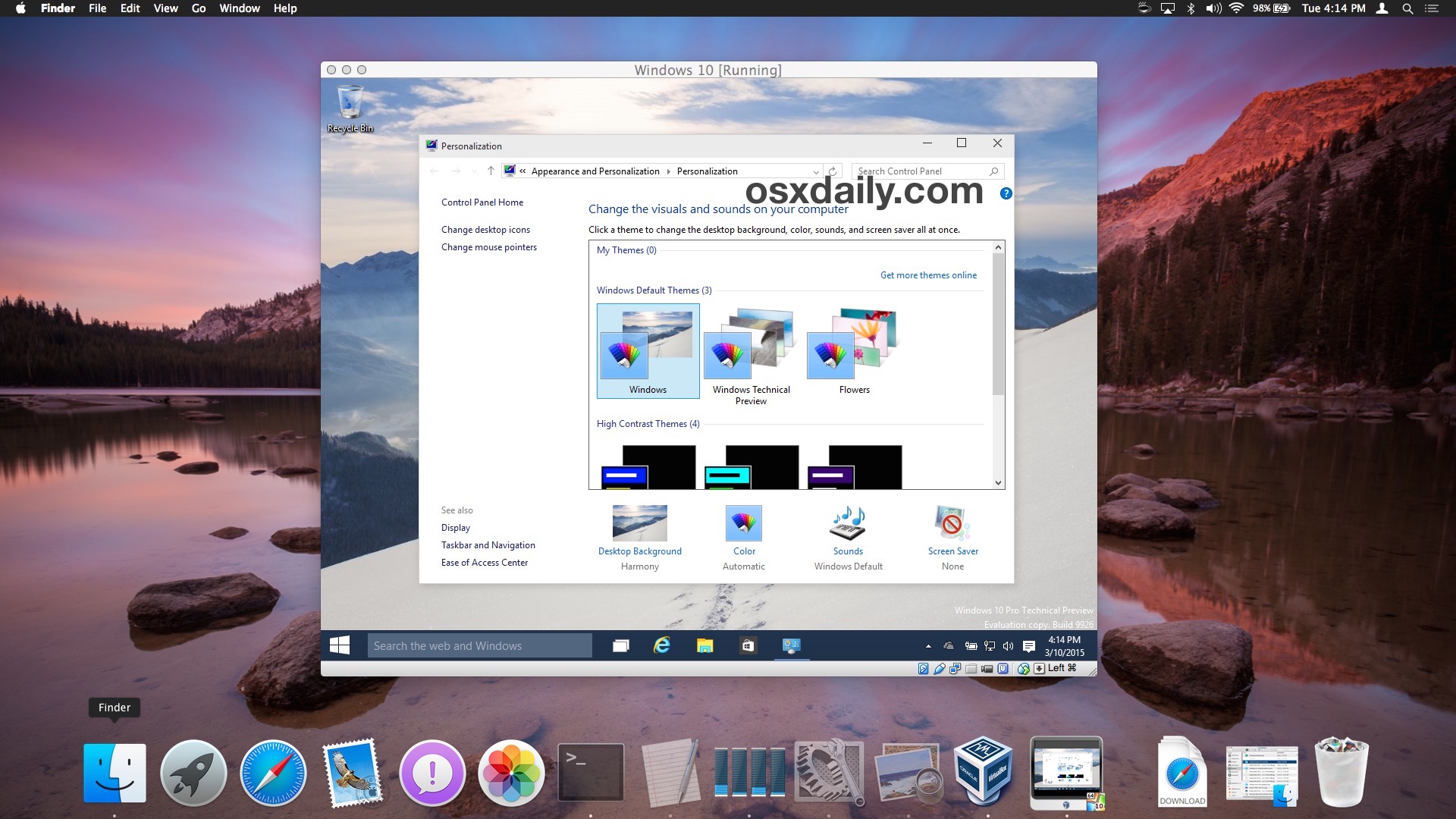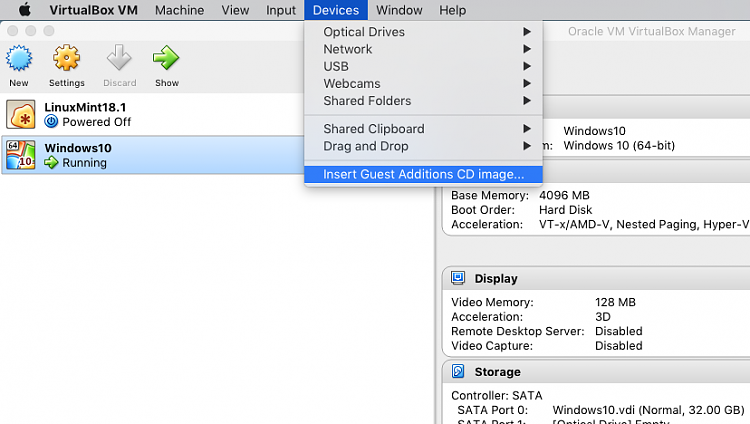VirtualBox is free software that allows you to install different operating systems on your machine. By using VirtualBox, you can install Windows on your Mac. This enables you to run Windows-only applications on your Mac. Here are the main steps involved in installing Windows on a Mac: Download and Install VirtualBox; Create a Virtual Machine. VirtualBox version: Version 6.0.22 r137980. The host and guest OSes and versions: Windows 10 Host, Guest Ubuntu 20.04.2 LTS. Whether you've installed Host Extensions & Guest Additions - Guest CD additions installed. A detailed explanation of the problem, and all steps you've taken to solve it so far. An updated version of my most popular tutorial, How to install Windows 10 in VirtualBox on your Mac! Hope you all enjoy! If you have not checked my first tut. Follow the steps below to create a new virtual machine for macOS Mojave using the ISO file. Open up your VirtualBox application and click New Click Expert Mode and select the following options then click Create. Type a suitable Virtual Machine Name.
Since the sixteenth massive update of the Mac operating system is finally live now with the most recent features and app. macOS Catalina’s name was encouraged by Santa Catalina Island, commonly known as Catalina. This operating system is significant update than macOS Mojave and much from macOS High Sierra. macOS Catalina is also the first version of macOS to support only 64-bit applications and the first to include Activation Lock, Sidecar and a bunch of other unique features. In this article, I’ll show how to Install macOS 10.15 Catalina on VirtualBox on AMD Systems.
The macOS Catalina runs typically on all the Macs that run Mojave. Even if it doesn’t, as well, you can definitely install macOS Catalina on your unsupported Mac. Catalina requires at least a 4GB of memory an addition 2 GB which runs Mojave. The macOS Catalina is one of the incredible operating systems. That you can not only install on Macs but also install Catalina on any version of Windows. You can also download other versions of MacOS with the help of the virtual machines such as VirtualBox and VMware.
The macOS Catalina is developed with the most amazing features and even updated than macOS Mojave and macOS Catalina. However, macOS Mojave and macOS High Sierra have also their own features, and improvements. But in macOS Catalina, in addition to those features, macOS Catalina has even more and better and improved those available features in it. You can probably download and install macOS Catalina, macOS Mojave and even macOS High Sierra on any Windows you’d like to. Here’s how to Install macOS 10.15 Catalina on VirtualBox on AMD Systems.
macOS Catalina
None of Apple’s operating system is useless and every one of them has its own benefits and advantages. But the only difference is that the new operating is more advanced features from the previous one. It also makes our work easier from the previous one. This new operating system opens the way for more creativity with its new features and apps. Such as Podcasts app, new Sidecar feature, Find My, new Photos interface, Reminders app, Voice Control, Dashboard feature, Apple TV app, iTunes Music Store and more other features and apps which are the most helpful, useful and effective.
If you want to download these files so we have provided that all downloading files for you guys. So if you want to download any of them, simply click, download them and enjoy them with all their features.
What is VirtualBox
VirtualBox is an open-source virtualization tool for 32 and 64-bit hardware. That is installed with server and desktop targeting and usage, allowing administrators to install and manage multiple operating systems on a single server. VirtualBox is designed for owners and guests. VirtualBox also allows supervisors and developers to quickly switch between guest and host. To know about these two, guest is any supported operating system running as a VM. A VirtualBox host can be run on Linux, Windows, or macOS.
Using VirtualBox, supervisors can adapt the host from ISO images or VDI / VMDK / VHD images. The most important and beneficial thing for a user is that it is free anyone can use it and easily can run as administrators. It’s also an easy route for testing and developing platforms.
What is AMD System (Advanced Micro Devices)
AMD (Advanced Micro Devices) is the second-largest producer of personal computer microprocessors after Intel. They also create flash memory, integrated circuits for network devices and programable logic devices. Intel and AMD (Advanced Micro Devices) are two of the most competitve names in technology. Create chips that power millions of computers, graphics cards, servers, and other devices.
So what’s the difference between Intel and AMD. AMD processors has lots plus points, including power, graphics and speed performance, and processing power. In comparison, Intel processors are more expensive than AMD. In terms of performance, AMD chips perform well for editing and some other tasks.
Install macOS 10.15 Catalina on VirtualBox on AMD System
Now it’s the time to install macOS Catalina on VirtualBox on AMD Systems. So if you want to install it without any problems and issues, follow the steps carefully and attentively. It’s quite easy and interesting also it doesn’t take too much time. The macOS Catalina installation on AMD is a little different from the installation of macOS Catalina on Intel. how to Install macOS 10.15 Catalina on VirtualBox on AMD Systems.
1# Enter Commands For The Virtual Machine
As there’s little difference, particularly the difference is in the commands step. The commands for Intel is different and the commands for AMD are different. Rest of the steps are all fine and you can continue the installation. When you’re in this step, follow these steps.
First of all, open Run by pressing Windows + R then type Notepad and hit Enter.
Run
When Notepad is opened, copy this command from below then paste it to Notepad.
After pasting this code press Ctrl+ H for opening Replace window. Now type “Your Virtual Machine Name” in the first tab and on the second window with blank, write down your virtual machine name exactly without any difference. At last, click on Replace all. It will change the names of the virtual machine.

Now, without saving it, launch Command Prompt in your Start Menu and open that.
After you’ve done that, copy and paste all of the commands and click Enter.
Command Prompt
2# Boot macOS Catalina on VirtualBox

Now open your VirtualBox then click on Start.
When the screen appears, straightly press Esc and type “install.nsh” to start the installation.
Install.nsh
3# Install macOS 10.15 Catalina on VirtualBox on AMD Systems
In a few minutes, macOS Catalina will be installed in VirtualBox.
After installation, the virtual machine will restart, but this time it will a real installation where you need to personalize, create an account and more.
Welcome

After the settings up finished, then the macOS Catalina will be successfully installed.
Now everything is done you can macOS Catalina is running in your PC. You can continue and install macOS Catalina completely if you’ve left something.
We’ve done our best to help you. We hope everything should work. However, if you encounter some problem, we’ve the comments forum open for you.
Here I explain how to install Windows on a Mac using the (free) virtualization software, VirtualBox.

VirtualBox is free software that allows you to install different operating systems on your machine. By using VirtualBox, you can install Windows on your Mac. This enables you to run Windows-only applications on your Mac.
Here are the main steps involved in installing Windows on a Mac:
- Download and Install VirtualBox
- Create a Virtual Machine
- Download and Install Windows
Here they are in more detail.
Download and Install VirtualBox
To run Windows on a Mac, you need to use virtualization software such as VirtualBox. While there are other options available (such as Parallels and VMware Fusion), VirtualBox is free. And while Bootcamp is also a free option, it doesn't let you run macOS and Windows simultaneously (you have to reboot the machine every time you want to switch to the other operating system). So with VirtualBox you get the best of both worlds — it's free, and it allows you to run both Windows and macOS simultaneously so you can switch between them as required without having to reboot.
Download VirtualBox
Go to the VirtualBox download page and click OS X Hosts.
Install VirtualBox
Double-click the VirtualBox.pkg icon to install VirtualBox. This will enable you to run VirtualBox from your Applications folder.
Create a Virtual Machine
Now that you've installed VirtualBox, you can create a virtual machine. This virtual machine is where you'll install Windows.
Install Mac Os On Virtualbox
Launch VirtualBox
Launch VirtualBox via the Applications folder (just as you'd launch any other application).
Start the Wizard
Click New to start the process of creating a new virtual machine.
Name and Operating System
Enter a name for the virtual machine (make it descriptive, such as
Windows 10 or similar).Also choose Microsoft Windows and select the 64 bit version (unless you have reason to choose the 32 bit version).
Click Continue.
Set the Memory Allocation
Use the slider to specify how much memory is allocated to the virtual machine. I selected 4 GB (4000 MB), which should be sufficient to run SQL Server inside Windows. If your Mac has a lot more RAM, then you might be able to allocate more to the virtual machine.
Click Continue.
Hard Disk
Leave it at the default setting and click Create.
Hard Disk File Type
Leave it at the default setting and click Continue.
Storage on Physical Hard Disk
Leave it at the default setting and click Continue.
File Location and Size
Leave it at the default setting and click Create.
Done!
Your new virtual machine has been created. It appears in the left pane of the VirtualBox home screen.
This is where you launch your virtual machine from whenever you need to use Windows.
Download and Install Windows
Run Mac Os On Windows 10 Using Virtualbox
Download the Windows Disk Image
Go to the Windows download page and select the latest version of Windows. Follow the prompts to download the ISO file to your Mac.
Alternatively, go to the Microsoft Evaluation Center and download a free evaluation trial. This is the option I used in this tutorial. This tutorial uses the Windows 10 Enterprise Evaluation edition (which is free to use for 90 days).
Download the file to your VirtualBox VMs folder (e.g. /Users/Dave/VirtualBox VMs/) or move it there once downloaded.
Start the Installation
Double-click on the virtual machine that you created previously.
Select the Windows Disk Image
Use the interface to browse to, and select, the Windows ISO file that you downloaded.
Click Start.
Select Language, etc
Select your language and other preferences, then click Next.
License Agreement
Select I accept the license terms and click Next.
Installation Type
Select Custom: Install Windows only (advanced).
Select the Drive
Here, the 50 GB drive (that you created when you created your virtual machine previously) should already be selected. If not, select it.
Click Next.
Select Keyboard Layout
Select your preferred keyboard layout and click Yes.
Add Another Keyboard?
Click Skip (unless you want to add another keyboard, in which case click Add layout and follow the prompts).
Join Domain
Microsoft wants you to sign in but for the purposes of this tutorial, we won't be doing that.
For this tutorial, click Domain join instead.
If you have an account with Office 365 or other business services, then feel free to sign in using that account instead.
Add Name
Add your name (or pseudonym) and click Next.
Confirm Password
Enter your password again to confirm and click Next.
Cortana?
Click either Yes or No depending on whether you want to use the Cortana personal assistant. (In this case I chose No.)
Privacy Settings
Disable any privacy settings you want to, then click Accept.
Finally... Done!
Windows is now installed. The Windows desktop is displayed, and you can now go ahead and start using Windows on your Mac!
